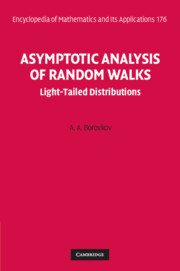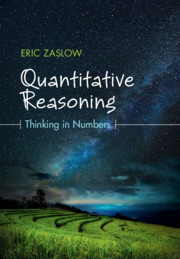Refine search
Actions for selected content:
6993 results in Mathematical modeling and methods

Thinking Probabilistically
- Stochastic Processes, Disordered Systems, and Their Applications
-
- Published online:
- 15 December 2020
- Print publication:
- 17 December 2020
EVOLUTIONARY DYNAMICS IN DISCRETE TIME FOR THE PERTURBED POSITIVE DEFINITE REPLICATOR EQUATION
- Part of
-
- Journal:
- The ANZIAM Journal / Volume 62 / Issue 2 / April 2020
- Published online by Cambridge University Press:
- 09 December 2020, pp. 148-184
-
- Article
-
- You have access
- Export citation
ASYMPTOTIC BEHAVIOUR OF THE STOCHASTIC MAKI–THOMPSON MODEL WITH A FORGETTING MECHANISM ON OPEN POPULATIONS
- Part of
-
- Journal:
- The ANZIAM Journal / Volume 62 / Issue 2 / April 2020
- Published online by Cambridge University Press:
- 06 November 2020, pp. 185-208
-
- Article
-
- You have access
- Export citation
IMPLEMENTATION OF HIGH-ORDER, DISCONTINUOUS GALERKIN TIME STEPPING FOR FRACTIONAL DIFFUSION PROBLEMS
- Part of
-
- Journal:
- The ANZIAM Journal / Volume 62 / Issue 2 / April 2020
- Published online by Cambridge University Press:
- 06 November 2020, pp. 121-147
-
- Article
-
- You have access
- Export citation
MEAN–VARIANCE EQUILIBRIUM ASSET-LIABILITY MANAGEMENT STRATEGY WITH COINTEGRATED ASSETS
- Part of
-
- Journal:
- The ANZIAM Journal / Volume 62 / Issue 2 / April 2020
- Published online by Cambridge University Press:
- 06 November 2020, pp. 209-234
-
- Article
-
- You have access
- Export citation
References
-
- Book:
- Asymptotic Analysis of Random Walks
- Published online:
- 16 October 2020
- Print publication:
- 29 October 2020, pp 410-418
-
- Chapter
- Export citation
6 - Some applications to problems in mathematical statistics
-
- Book:
- Asymptotic Analysis of Random Walks
- Published online:
- 16 October 2020
- Print publication:
- 29 October 2020, pp 375-406
-
- Chapter
- Export citation
4 - Large deviation principles for random walk trajectories
-
- Book:
- Asymptotic Analysis of Random Walks
- Published online:
- 16 October 2020
- Print publication:
- 29 October 2020, pp 234-342
-
- Chapter
- Export citation
Index
-
- Book:
- Asymptotic Analysis of Random Walks
- Published online:
- 16 October 2020
- Print publication:
- 29 October 2020, pp 419-420
-
- Chapter
- Export citation
Contents
-
- Book:
- Asymptotic Analysis of Random Walks
- Published online:
- 16 October 2020
- Print publication:
- 29 October 2020, pp v-viii
-
- Chapter
- Export citation
5 - Moderately large deviation principles for the trajectories of random walks and processes with independent increments
-
- Book:
- Asymptotic Analysis of Random Walks
- Published online:
- 16 October 2020
- Print publication:
- 29 October 2020, pp 343-374
-
- Chapter
- Export citation
1 - Preliminary results
-
- Book:
- Asymptotic Analysis of Random Walks
- Published online:
- 16 October 2020
- Print publication:
- 29 October 2020, pp 1-38
-
- Chapter
- Export citation
Introduction
-
- Book:
- Asymptotic Analysis of Random Walks
- Published online:
- 16 October 2020
- Print publication:
- 29 October 2020, pp ix-xvi
-
- Chapter
- Export citation
Basic notation
-
- Book:
- Asymptotic Analysis of Random Walks
- Published online:
- 16 October 2020
- Print publication:
- 29 October 2020, pp 407-409
-
- Chapter
- Export citation
3 - Boundary crossing problems for random walks
-
- Book:
- Asymptotic Analysis of Random Walks
- Published online:
- 16 October 2020
- Print publication:
- 29 October 2020, pp 136-233
-
- Chapter
- Export citation
Frontmatter
-
- Book:
- Asymptotic Analysis of Random Walks
- Published online:
- 16 October 2020
- Print publication:
- 29 October 2020, pp i-iv
-
- Chapter
- Export citation
2 - Approximation of distributions of sums of random variables
-
- Book:
- Asymptotic Analysis of Random Walks
- Published online:
- 16 October 2020
- Print publication:
- 29 October 2020, pp 39-135
-
- Chapter
- Export citation

Asymptotic Analysis of Random Walks
- Light-Tailed Distributions
-
- Published online:
- 16 October 2020
- Print publication:
- 29 October 2020

Quantitative Reasoning
- Thinking in Numbers
-
- Published online:
- 21 September 2020
- Print publication:
- 16 January 2020
-
- Textbook
- Export citation
ANZ VOLUME 62 ISSUE 1 COVER AND FRONT MATTER
-
- Journal:
- The ANZIAM Journal / Volume 62 / Issue 1 / January 2020
- Published online by Cambridge University Press:
- 04 August 2020, pp. f1-f2
-
- Article
-
- You have access
- Export citation
